Aaron Hager, Extension Weeds Specialist, University of Illinois
The last day to apply dicamba-containing products to dicamba-resistant soybean is Monday, June 20. Applicators are reminded that applications of dicamba-containing products to dicamba-resistant soybean are not allowed if the actual or forecast air temperature the day of application exceeds 85 degrees.
Nick Seiter, Extension Field Crops Insect Specialist, University of Illinois
Rootworm larvae are now easy to find in our trial field in Champaign; egg hatch should be underway throughout the state now. This is a good time to dig some plants up and look for larvae to get a feel for the level of larval feeding pressure you might be experiencing, as well as an initial idea of control performance. Watch for areas experiencing symptoms of drought stress despite what should be adequate moisture as an above-ground indication of rootworm feeding. If you’re interested in rootworm trapping this summer, send me an email at nseiter@illinois.edu.
Emerson Nafziger, Extension Agronomy Specialist, University of Illinois
While corn and soybean condition ratings continue to be very good, there are concerns about ongoing lack of rainfall and high temperatures. Nearly all of Illinois has had below-normal rainfall the first half of June, and this, along with high temperatures, are forecast to continue through next week. This has not yet lowered yield potential in most fields, but as leaf area expands and daily water use increases, we can expect symptoms of water stress to appear in more fields, and to appear earlier in the day as soil water decreases. Mineralization of nitrogen from soil organic matter as been high, and N loss has been minimal, so the N supply for the corn crop is good. If more N is needed, injecting UAN rather than dribbling it on the soil surface will help prevent volatilization loss.
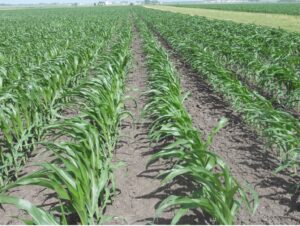
Corn at V6-V7 showing moderate water stress on June 15, 2022, with temperature of 98 degrees F.
Talon Becker, Commercial Agriculture Extension Educator, Southern IL
Hot, dry, and windy weather this past week has dried things out considerably. Corn that is at the V1-V2 stage with smaller root systems is starting to look wilted and stressed in some areas, particularly fields where spring tillage was performed. Most soybeans in the area are just at VC-V1, although there are a few fields I’ve seen closer to the V2-V3 growth stage. Moisture stress has been less visible in soybeans from my road surveys, but the fact that most beans in this area are planted no-till may have bought them a few extra days before the moisture in the top several inches of soil depletes.
Nathan Johanning, Commercial Agriculture Extension Educator, Southwestern IL
It is hot and dry. Crops are feeling the pressure of multiple days of highs in the upper 90s and lows only getting to the upper 70s to 80 and intense sun. We have only gotten a few sprinkles of rain in the last week and crops are starting to show some signs of stress in the afternoons. Wheat, on the other hand, is greatly benefiting from this weather and is drying quickly. I have seen a few farmers start cutting wheat. The fields I checked, kernels were still soft to starting to get a bit of a crunch to them so maybe roughly 20% moisture. With weather like we have now that moisture will disappear in a hurry!
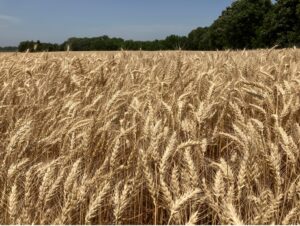
Current wheat maturity in Monroe County, IL.
Doug Gucker, Local Foods Small Farms Extension Educator, Central IL
This past week has seen temperatures across the area from the mid-70s to the upper 90s deg. F. Rainfall for the month is running at a deficit of 1.75 – 2″ since June 1. Shallow soil moisture is dry, but crops are still looking good due to adequate subsoil moisture. End rows on a few fields are showing the effects of crops having difficulty reaching subsoil moisture. All fields appear to be planted now with corn development varying for V3 – V7 and soybeans development varying from unifoliate to R1. Still seeing fields where weeds in the amaranth family over 8 inches tall are trying to be controlled with post-emergent herbicide applications.
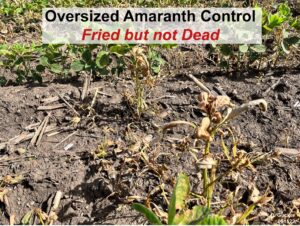
Oversized amaranth trying to be controlled with post-emergent herbicide application.
Phillip Alberti, Commercial Agriculture Extension Educator, Northern IL
Remarkable how fast conditions can change. As expected, extremely dry, hot conditions have hit the region hard. Earlier planted corn and soybeans are the better for it with deeper root systems that can handle these early season dry periods better. Corn (V2-4) and soybeans (V2-V3) in the region have shown promise with good stand establishment and some favorable conditions, but with no relief in sight, we are hoping for a few pop-up storms to provide some relief.
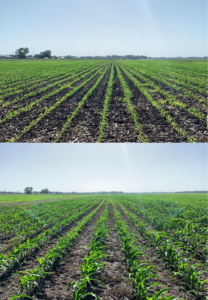
Corn fields planted ~7 days from each other in the same field in Oglesby, IL.
Kathryn Kamman, ILSoyAdvisor Soy Envoy
Hot and humid, the week leading up to summer is packing in the summer weather. Crops are starting to show the sins of the planting season. Areas that were planted in wetter conditions are stunted, lighter green, and not able to supply the plant with the needed water and nutrients, leaving an uneven field appearance. Soybeans are starting to flower in those earlier planted fields. No signs of drought stress, yet, but with the high temps in the future forecast and little to no rain chances, things will start drying up quickly.
Weston Olson, ILSoyAdvisor Soy Envoy
This week, the corn seems like it is in full acceleration growing mode which is great, but I do worry a bit about what toll these hot days and nights will take on this crop. Our moisture seems adequate for now but with next week forecasted to be hot again, crops may begin to suffer, praying for a decent rain. Soybeans are flowering or about to flower, but in need of spraying. I planted Xtend® beans one more year and thought I had it sprayed but got rained out prior to the heat wave, so now I’m just hoping we can get it sprayed either Friday or Saturday with the cool down into the right temperature and a wind that is gentle. Around us the crops are quite variable, even more than usual, as I have seen crops just coming out, soybeans and others flowering, and corn that is waist- or stomach-high to not even knee-high. This is common, but this year seems to be even more pronounced of a difference field by field.
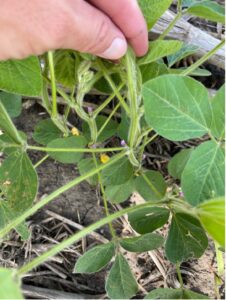
Flowering beans on 6/15/22 awaiting the Summer Solstice.
Brad Zimmerman, ILSoyAdvisor Soy Envoy
Working on the tan this week! While the dry weather (only a few shots of precipitation last week) has allowed for spraying and cultivating, the winds have limited some of the spraying efforts. We have been busy scouting fields and gathering soil and tissue tests to monitor what is in the soil vs what makes it into the plant. This will take place 5 times during the growing season to get a picture of what is missing (or excessive) during the year. Corn is looking very good as this is optimal corn-growing weather, but some of the soybean stands look to be a little thin. We should see plenty of growth stages being hit this next week.




 and then
and then